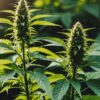Cannabis Chemistry is an exciting and fast-growing field in the United States. It combines plant science, chemistry, and technology to understand and utilize cannabis for various applications, from medical uses to industrial production. This article explores the molecular structure of cannabinoids, analytical techniques, cultivation methods, medical applications, educational pathways, and career opportunities in cannabis chemistry.
Key Takeaways
- Cannabis Chemistry is a rapidly growing industry in the U.S., offering numerous career opportunities.
- Understanding the molecular structure of cannabinoids like THC and CBD is crucial for their medical and recreational use.
- Various analytical techniques, such as liquid chromatography and spectroscopy, are used to study cannabis compounds.
- Modern cultivation techniques and strict regulations ensure the safe production of cannabis.
- Educational programs in Cannabis Chemistry provide the necessary knowledge and skills for a successful career in this field.
The Molecular Structure of Cannabinoids
Understanding THC and CBD
Cannabinoids are unique compounds found in cannabis. The most well-known are THC and CBD. THC is the main psychoactive component that makes people feel "high." On the other hand, CBD does not cause a high but has other effects like reducing anxiety. Both THC and CBD have the same molecular formula, C21H30O2, but their structures are different, leading to different effects on the body.
Other Cannabinoids in Cannabis
Besides THC and CBD, cannabis contains other cannabinoids like CBN, cannabivarins, and cannabichromenes. These compounds also have unique effects. For example, CBN is found in aged cannabis and can make you feel sleepy. Cannabinoids are not nitrogenous bases, which makes them different from many other psychoactive substances.
Pharmacological Effects of Cannabinoids
Cannabinoids affect the body in various ways. At low doses, they can make you feel happy, calm, and sleepy. Some effects are similar to those of alcohol. When you smoke cannabis, THC enters your blood quickly and has a half-life of about 2 hours. The body also has its own cannabinoid, called anandamide, which works similarly to THC.
The science behind cannabinoids is complex, involving many different compounds and effects. Understanding these can help us better use cannabis for medical and recreational purposes.
Analytical Techniques in Cannabis Chemistry
Liquid Chromatography
Liquid chromatography is a key method for measuring chemicals in cannabis. Commonly, labs will test for tetrahydrocannabinolic acid (THCA) and δ9-tetrahydrocannabinol (δ9-THC) and report “total potency,” because THCA rapidly converts to THC when heated. This technique helps in identifying and quantifying various cannabinoids and contaminants.
Spectroscopy Methods
Spectroscopy methods, such as mass spectrometry, are used to identify the molecular structure of cannabinoids. The mass spectrum of THC shows major ions at specific mass-to-charge ratios (m/z). These methods are essential for ensuring the quality and safety of cannabis products by detecting harmful substances like pesticides and heavy metals.
Saliva Testing for Cannabis
Saliva testing is a non-invasive method to detect recent cannabis use. This technique is often used in roadside testing and workplace compliance. It can identify the presence of THC and other cannabinoids, providing quick and reliable results.
Analytical techniques in cannabis chemistry are crucial for ensuring product safety and compliance with regulations. They help in identifying the chemical composition and potential contaminants in cannabis products.
Cannabis Cultivation and Production
Hemp Production During World War II
During World War II, hemp was a crucial crop for the war effort. The U.S. government even launched a "Hemp for Victory" campaign to encourage farmers to grow hemp for making ropes, sails, and other essential items. Hemp’s versatility made it an invaluable resource during this time.
Modern Growing Techniques
Today, cannabis cultivation has advanced significantly. Intensive indoor cultivation has become widespread, especially in Europe. This method uses improved seed varieties and techniques like artificial heating and lighting, hydroponic cultivation in nutrient solutions, and propagation of cuttings from female plants. These methods lead to high production of flowering material, sometimes known as ‘skunk.’
Regulations and Compliance
Growing cannabis is subject to strict regulations and compliance standards. Farmers must adhere to guidelines regarding the use of pesticides, water, and other resources. Compliance ensures that the cannabis produced is safe for consumption and meets quality standards.
Understanding the basics of cannabis plant cultivation, including soil and nutrient management, is essential for successful growth.
Farmers and producers must stay updated on changing laws and regulations to remain compliant and avoid legal issues.
Medical Applications of Cannabis
Therapeutic Uses of THC and CBD
Cannabis has been used to help with many health problems. Medical marijuana can ease pain, reduce nausea, and help with muscle spasms. THC and CBD, two main compounds in cannabis, are often used in treatments. In some places, doctors can prescribe cannabis for conditions like multiple sclerosis and certain types of pain.
Clinical Trials and Research
Scientists are studying cannabis to understand how it works and how it can help people. Clinical trials are important because they test the safety and effectiveness of cannabis treatments. These studies help doctors know the best ways to use cannabis for health problems.
Safety and Efficacy
When using cannabis for medical reasons, it’s important to know it’s safe and works well. Doctors and researchers look at the benefits and risks. They want to make sure that cannabis helps more than it harms. This is why ongoing research and careful testing are so important.
Cannabis can be a helpful tool in medicine, but it must be used carefully and wisely.
Educational Pathways in Cannabis Chemistry
Degree Programs and Requirements
Students interested in cannabis chemistry can pursue various educational pathways. One option is a Bachelor of Science in Cannabis Chemistry. This degree provides a solid foundation in chemistry, including courses in organic chemistry, instrumental analysis, and biochemistry. Additionally, students gain hands-on experience in state-of-the-art instrumentation laboratories, preparing them for careers in law enforcement, public health, and regulatory management.
Core Courses Overview
The core courses in a cannabis chemistry program cover a wide range of topics. Students are required to complete 6 courses that encompass the context and science of cannabis, horticulture science, plant production systems, and nursery management. These courses teach laboratory theory and skills that can be used in any testing facility, with an emphasis on cannabis and its compounds.
Internship and Research Opportunities
Internship and research opportunities are crucial for students in cannabis chemistry programs. Graduates earn over 600 hours of experience in industry-standard techniques, giving them the proficiency needed to work in various fields. These opportunities often include working in analytical laboratories, participating in research projects, and attending seminars with invited speakers.
The newness of the medical and recreational cannabis industry means there are many paths to a career in this field. Whether you’re interested in cultivation, extraction, or business applications, there’s a pathway for you.
Career Opportunities in Cannabis Chemistry
Research and Development
Graduates in Cannabis Chemistry can dive into research and development roles. These positions often involve studying the properties and effects of cannabinoids, developing new cannabis-based products, and improving existing formulations. The field is dynamic, with opportunities to work in both academic and commercial settings.
Quality Control and Regulation
Ensuring the safety and efficacy of cannabis products is crucial. Quality control and regulation roles focus on testing products for contaminants, verifying potency, and ensuring compliance with state and federal laws. Professionals in this area often work in laboratories, using state-of-the-art instrumentation to maintain high standards.
Sales and Marketing
The cannabis industry also offers exciting opportunities in sales and marketing. These roles involve promoting cannabis products, educating consumers, and developing brand strategies. A strong understanding of cannabis chemistry can be a significant advantage in effectively communicating product benefits and ensuring customer satisfaction.
With over 600 hours of hands-on experience in advanced labs, graduates are well-prepared for various roles in the cannabis industry.
Job Titles in Cannabis Chemistry:
- Cultivation Technician
- Cannabis Chemist
- Analytical Chemist
- Extraction Technician
- Lab Testing Professional
- Product Developer
For those looking to further their education, advanced degrees can lead to roles such as Biochemistry Educator, Plant Geneticist, or Medical Researcher. The cannabis industry is growing rapidly, and there are numerous opportunities for those with the right skills and knowledge.
Conclusion
Cannabis chemistry is a rapidly growing field with a lot of potential. From understanding the molecular structure of cannabinoids to learning about their various applications, this area of study offers a wealth of knowledge and opportunities. Whether you’re interested in the medical benefits of CBD and THC, or the business side of cannabis production and sales, there’s something for everyone. As the industry continues to expand, the demand for skilled professionals will only increase. By pursuing a degree in cannabis chemistry, you can be at the forefront of this exciting and innovative field.
Frequently Asked Questions
What is Cannabis Chemistry?
Cannabis Chemistry is the study of the chemical compounds found in cannabis plants. It includes understanding substances like THC and CBD, their effects, and how to test and produce them.
What are cannabinoids?
Cannabinoids are chemical compounds found in cannabis. The most known ones are THC, which makes you feel high, and CBD, which is used for medical purposes.
How is cannabis tested?
Cannabis is tested using methods like liquid chromatography and spectroscopy. These techniques help find out the potency and safety of the cannabis.
What can you do with a degree in Cannabis Chemistry?
With a degree in Cannabis Chemistry, you can work in research, quality control, product development, and even sales and marketing within the cannabis industry.
Is cannabis used for medical purposes?
Yes, cannabis is used for medical purposes. THC and CBD, two main compounds in cannabis, are used to treat conditions like pain, anxiety, and epilepsy.
Are there any risks with using cannabis?
Yes, there are risks with using cannabis. It can affect your memory, coordination, and even lead to addiction if used improperly.




